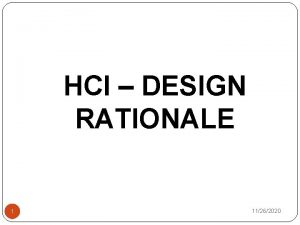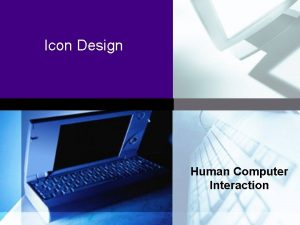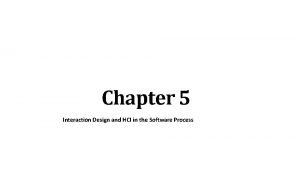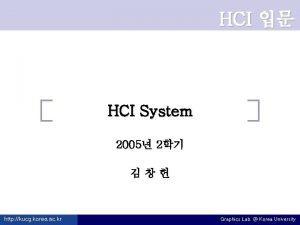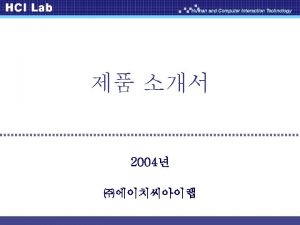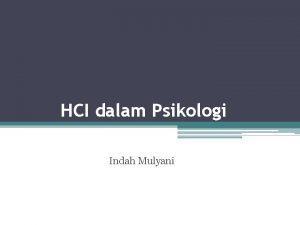HCI DESIGN RATIONALE 1 12152021 Design rationale The












- Slides: 12

HCI – DESIGN RATIONALE 1 12/15/2021

Design rationale The information that explains why a computer system is the way it is, including its structural or architectural description and its functional or behavioral description. relates to an activity of both reflection (doing design rationale) and documentation (creating a design rationale) that occurs throughout the entire life cycle. It is beneficial to have access to the design rationale for several reasons: In an explicit form, a design rationale provides a communication mechanism among the members of a design team. so that this can help avoid incorrect assumptions later. Accumulated knowledge in the form of design rationales for a set of products can be reused to transfer what has worked in one situation to another situation which has similar needs. The process of deliberation can be assisted by the design rationale technique. 2 12/15/2021

Design Rules rules a designer can follow in order to increase the usability of the eventual software product. different types of design rules. Principles Standards Guidelines Abstract principles offer a way of understanding usability Design rules in the form of standards and guidelines provide direction for design, in both general and more concrete terms, in order to enhance the interactive properties of the system. The essential characteristics of good design are often summarized through ‘golden rules’ or heuristics. Design patterns provide a potentially generative approach to capturing and reusing design knowledge. 3 12/15/2021

Principles to support usability applied to the design of an interactive system in order to promote its usability. The principles divided into three main categories: 1. Learnability – the ease with which new users can begin effective interaction and achieve maximal performance. 2. Flexibility – the multiplicity of ways in which the user and system exchange information. 3. Robustness – the level of support provided to the user in determining successful achievement and assessment of goals. 4 12/15/2021

Principles of Learnability 5 12/15/2021

Principles of flexibility 6 12/15/2021

Principles of robustness 7 12/15/2021

Standards for interactive system design set by national or international bodies to ensure compliance with a set of design rules by a large community. Standards can apply specifically to either the hardware or the software used to build the interactive system. British Standards Institution (BSI) or the International Organization for Standardization (ISO) or a national military agency, has had standards for hardware in place before any for software. hardware standards more common than software high authority and low level of detail ISO 9241 defines usability as effectiveness, efficiency and satisfaction with which users accomplish tasks 8 12/15/2021

Guidelines The majority of design rules for interactive systems are suggestive and more general guidelines. Several books and technical reports contain huge catalogs of guidelines. Abstract guidelines (principles) applicable during early life cycle activities The detailed guidelines (style guides) applicable during later life cycle activities The basic categories of the Smith and Mosier guidelines are: 1. Data Entry 2. Data Display 3. Sequence Control 4. User Guidance 5. Data Transmission 6. Data Protection 9 12/15/2021

Golden rules and heuristics The sets of ‘golden rules’ or heuristics are ‘broad-brush’ design rules, which may not be always be applicable to every situation, They do provide a useful checklist or summary of the essence of design advice. Any designer following even these simple rules will produce a better system than one who ignores them. Sets of heuristics, are Nielsen’s ten heuristics, Shneiderman’s eight golden rules and Norman’s seven principles. Nielsen’s heuristics are intended to be used in evaluation. Shneiderman’s 8 Golden Rules 1. Strive for consistency 2. Enable frequent users to use shortcuts 3. Offer informative feedback 4. Design dialogs to yield closure 5. Offer error prevention and simple error handling 6. Permit easy reversal of actions 7. Support internal locus of control 8. Reduce short-term memory load 10 12/15/2021

Golden rules and heuristics con… Norman’s 7 Principles Norman’s seven principles provide a useful summary of his user-centered design philosophy 1. Use both knowledge in the world and knowledge in the head. 2. Simplify the structure of tasks. 3. Make things visible: bridge the gulfs of Execution and Evaluation. 4. Get the mappings right. 5. Exploit the power of constraints, both natural and artificial. 6. Design for error. 7. When all else fails, standardize. 11 12/15/2021

HCI Design Patterns An approach to reusing knowledge about successful design solutions Originated in architecture: Alexander A pattern is an invariant solution to a recurrent problem within a specific context. Patterns do not exist in isolation but are linked to other patterns in languages which enable complete designs to be generated Characteristics of patterns capture design practice not theory capture the essential common properties of good examples of design represent design knowledge at varying levels: social, organisational, conceptual, detailed embody values and can express what is humane in interface design are intuitive and readable and can therefore be used for communication between all stakeholders a pattern language should be generative and assist in the development of complete designs. 12 12/15/2021
